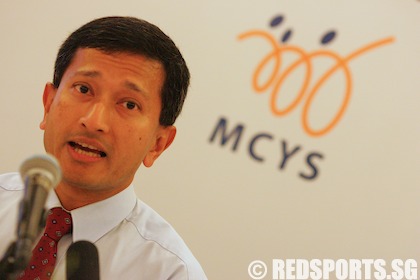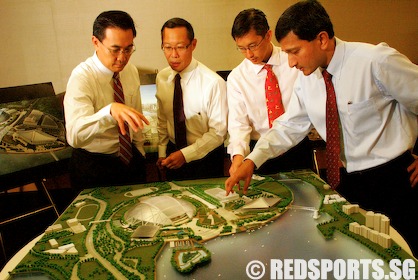By Laura Reid

Dr Vivian Balakhrisnan, Minister for the Ministry Community Development, Youth and Sports (MCYS), announcing the preferred bidder. (Photo 1 © Les Tan/Red Sports)
Ritz Carlton Hotel, Saturday, January 19, 2008 – The suspense is finally over as the biggest story in Singapore's sports history is just beginning: Singapore Sports Hub Consortium (SSHC) has been given the nod as the preferred bidder for the $1.2 billion sports development planned for the Kallang basin.
For Singapore, the Sports Hub will help position the country as the regional capital for sports, entertainment and leisure. "It will be a stage on which heroes can be created," said Dr. Vivian Balakrishnan, Minister of Community Development Youth and Sport, speaking at a press conference at the Ritz Carlton Hotel. "A place where memories can be made."
While he praised all three bidders for their proposals, Dr. Balakrishnan said the decisive factor in SSHC's favour was the holistic structure of its bid. Not only does it have a balance of regional and international events, SSHC plans to draw on community and grassroots sports to bring people and events to the complex year-round.
Led by Dragages Singapore Pte Ltd, SSHC has put up a sports calendar for the new complex that commits to at least 90 event days at the new National Stadium and 46 event days at the adjacent Singapore Indoor Stadium. SHHC also plans to offer onsite media broadcasting services in addition to organizing an ASEAN clubs soccer league, a Singapore National and international cricket games.
The new Sports Hub complex is expected to be completed in late 2011, well in time for 2013 when Singapore is slated to host the South East Asian Games. However, as important as the new sports hub will be for Singapore's sporting culture, it will also be one of the important business stories of the next decade.
With an estimated construction cost of S$1.2 billion, the Sports Hub is a massive undertaking for Singapore. The government has minimized the risk to tax payers by making use of an innovative financing model – the first of its kind in the world for a sports project.
The Sports Hub will be financed through a public-private partnership (PPP) agreement, seen more commonly in public infrastructure projects such as power plants, hospitals and highways. Through the 25-year agreement with SSHC, the government effectively has passed all direct risk – both construction and operational – for the project to the consortium.
The government will not bear the cost of either direct capital expansion or operating and maintenance of the new Sports Hub complex. Instead, the government will pay an annual fee for services rendered over the course of the 25-year contract. The net present value (NPV) of the contract is estimated at $1.87 billion, if SSHC hits all the pre-determined benchmarks for service delivery. The contract is expected to be signed in March 2008.
"It's a significant sum of money," said Dr. Balakrishnan, adding that Singaporeans will have "the right to ask questions." However, he was quietly emphatic that the safety and merits of the PPP didn't lie solely in the legal details for the deal, but in the government's conviction that SSHC was the best choice for a 25-year partner.
The government was always clear on its criteria for the new development: a 55,000-seat stadium, a redevelopment of the existing Indoor Stadium with a capacity 12,000 seats, a multi-purpose indoor arena, an indoor aquatic centre cum water leisure centre and office space for the Singapore Sports Council, the Singapore National Olympic Council, the 58 National Sports Associations and, potentially, international sports federations. The government also wanted 41,000 square metres in commercial and retail space (roughly the equivalent Plaza Singapura) that would be blended into the overall complex.
Beyond the numbers, though, the government wanted to see the concept of legacy woven throughout the proposals. Many stadiums are built for a single event and then fall into disuse. "We didn't want a white elephant," Dr. Balakrishnan said, "We wanted a new icon for our people. ..where heroes are created, where we have rites of passage, where our memories are made."
As the new Sports Hub places Singapore centre stage both regionally and internationally, Dr. Balakrishnan said that the new National Stadium also will remind Singaporeans "that we are one people, one Singapore, one team."

The winning design by the Singapore Sports Hub Consortium. (Photo 2 © Les Tan/Red Sports)

The new National Stadium will provide a platform for a future generation of Singaporean sports heroes. (Photo 3 © Les Tan/Red Sports)

Oon Jin Teik (CEO, SSC), Alex Chan (Chairman, SSC), Teo Ser Luck (Parl Sec, MCYS) and Dr Vivian Balakrishnan (Minister, MCYS) with the model of the winning design. (Photo 3 © Les Tan/Red Sports)

Oon Jin Teik, CEO of the Singapore Sports Council. Said Jin Teik: “The “who’s who” of the sports, entertainment and financial world that applied for the first round … gave us the first indication of the project’s attractiveness.” (Photo 4 © Les Tan/Red Sports)











The SingaporeGOld should have win the bid.
At least with that we could show the world Singapore is unique